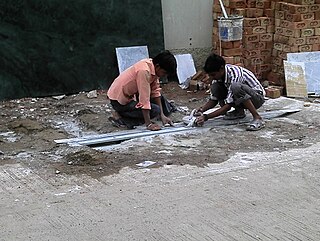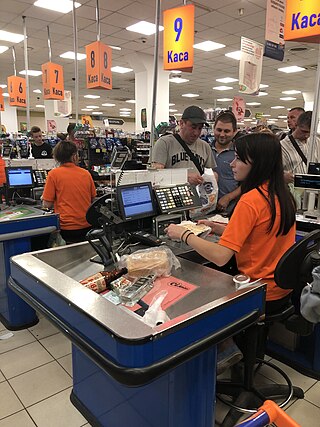Related Research Articles
The Occupational Safety and Health Administration is a regulatory agency of the United States Department of Labor that originally had federal visitorial powers to inspect and examine workplaces. The United States Congress established the agency under the Occupational Safety and Health Act, which President Richard M. Nixon signed into law on December 29, 1970. OSHA's mission is to "assure safe and healthy working conditions for working men and women by setting and enforcing standards and by providing training, outreach, education, and assistance." The agency is also charged with enforcing a variety of whistleblower statutes and regulations. OSHA's workplace safety inspections have been shown to reduce injury rates and injury costs without adverse effects on employment, sales, credit ratings, or firm survival.

The Occupational Safety and Health Act of 1970 is a US labor law governing the federal law of occupational health and safety in the private sector and federal government in the United States. It was enacted by Congress in 1970 and was signed by President Richard Nixon on December 29, 1970. Its main goal is to ensure that employers provide employees with an environment free from recognized hazards, such as exposure to toxic chemicals, excessive noise levels, mechanical dangers, heat or cold stress, or unsanitary conditions. The Act created the Occupational Safety and Health Administration (OSHA) and the National Institute for Occupational Safety and Health (NIOSH).
Construction site safety is an aspect of construction-related activities concerned with protecting construction site workers and others from death, injury, disease or other health-related risks. Construction is an often hazardous, predominantly land-based activity where site workers may be exposed to various risks, some of which remain unrecognized. Site risks can include working at height, moving machinery and materials, power tools and electrical equipment, hazardous substances, plus the effects of excessive noise, dust and vibration. The leading causes of construction site fatalities are falls, electrocutions, crush injuries, and caught-between injuries.
This article gives detailed information on the employment situation in Hong Kong.

Lock out, tag out or lockout–tagout (LOTO) is a safety procedure used to ensure that dangerous equipment is properly shut off and not able to be started up again prior to the completion of maintenance or repair work. It requires that hazardous energy sources be "isolated and rendered inoperative" before work is started on the equipment in question. The isolated power sources are then locked and a tag is placed on the lock identifying the worker and reason the LOTO is placed on it. The worker then holds the key for the lock, ensuring that only they can remove the lock and start the equipment. This prevents accidental startup of equipment while it is in a hazardous state or while a worker is in direct contact with it.

A roofer, roof mechanic, or roofing contractor is a tradesman who specializes in roof construction. Roofers replace, repair, and install the roofs of buildings, using a variety of materials, including shingles, single-ply, bitumen, and metal. Roofing work includes the hoisting, storage, application, and removal of roofing materials and equipment, including related insulation, sheet metal, vapor barrier work, and green technologies rooftop jobs such as vegetative roofs, rainwater harvesting systems, and photovoltaic products, such as solar shingles and solar tiles.

Hearing conservation programs are designed to prevent hearing loss due to noise. Hearing conservation programs require knowledge about risk factors such as noise and ototoxicity, hearing, hearing loss, protective measures to prevent hearing loss at home, in school, at work, in the military and, and at social/recreational events, and legislative requirements. Regarding occupational exposures to noise, a hearing conservation program is required by the Occupational Safety and Health Administration (OSHA) "whenever employee noise exposures equal or exceed an 8-hour time-weighted average sound level (TWA) of 85 decibels (dB) measured on the A scale or, equivalently, a dose of fifty percent." This 8-hour time-weighted average is known as an exposure action value. While the Mine Safety and Health Administration (MSHA) also requires a hearing conservation program, MSHA does not require a written hearing conservation program. MSHA's hearing conservation program requirement can be found in 30 CFR § 62.150, and is very similar to the OSHA hearing conservation program requirements. Therefore, only the OSHA standard 29 CFR 1910.95 will be discussed in detail.
North American Occupational Safety and Health (NAOSH) Week is an annual celebration that happens during the first full week of May. The aim of the event is to raise awareness about occupational safety, health, and the environment (OSH&E) in order to avoid workplace injuries and illnesses.
The WorkCover Authority of New South Wales was a New South Wales Government agency established in 1989. The agency created regulations to promote productive, healthy and safe workplaces for workers and employers in New South Wales. The agency formed part of the Safety, Return to Work and Support Division established pursuant to the Safety, Return to Work and Support Board Act, 2012 (NSW).
A safety management system (SMS) is a management system designed to manage occupational safety and health risks in the workplace. If the system contains elements of management of longer-term health impacts and occupational disease, it may be referred to as a safety and health management system (SHMS) or health and safety management system.
Prevention through design (PtD), also called safety by design usually in Europe, is the concept of applying methods to minimize occupational hazards early in the design process, with an emphasis on optimizing employee health and safety throughout the life cycle of materials and processes. It is a concept and movement that encourages construction or product designers to "design out" health and safety risks during design development. The process also encourages the various stakeholders within a construction project to be collaborative and share the responsibilities of workers' safety evenly. The concept supports the view that along with quality, programme and cost; safety is determined during the design stage. It increases the cost-effectiveness of enhancements to occupational safety and health.
The Workers' Compensation Board of British Columbia, operating as WorkSafeBC, is a statutory agency that was made in 1917, after the provincial legislature put into force legislation passed in 1902. This legislation is known as the Workers Compensation Act.
A lone worker (LW) is an employee who performs an activity that is carried out in isolation from other workers without close or direct supervision. Such staff may be exposed to risk because there is no-one to assist them and so a risk assessment may be required. Lone workers are now often supported by cloud-based automated monitoring systems and specialised monitoring call centres - often referred to as an 'Alarm Receiving Centre' or 'ARC' in the UK, or 'Emergency Dispatch Center' or 'EDC' in the US.

Occupational safety and health (OSH) or occupational health and safety (OHS) is a multidisciplinary field concerned with the safety, health, and welfare of people at work. OSH is related to the fields of occupational medicine and occupational hygiene and aligns with workplace health promotion initiatives. OSH also protects all the general public who may be affected by the occupational environment.

People who are driving as part of their work duties are an important road user category. First, workers themselves are at risk of road traffic injury. Contributing factors include fatigue and long work hours, delivery pressures, distractions from mobile phones and other devices, lack of training to operate the assigned vehicle, vehicle defects, use of prescription and non-prescription medications, medical conditions, and poor journey planning. Death, disability, or injury of a family wage earner due to road traffic injury, in addition to causing emotional pain and suffering, creates economic hardship for the injured worker and family members that may persist well beyond the event itself.

Occupational hearing loss (OHL) is hearing loss that occurs as a result of occupational hazards, such as excessive noise and ototoxic chemicals. Noise is a common workplace hazard, and recognized as the risk factor for noise-induced hearing loss and tinnitus but it is not the only risk factor that can result in a work-related hearing loss. Also, noise-induced hearing loss can result from exposures that are not restricted to the occupational setting.
Occupational heat stress is the net load to which a worker is exposed from the combined contributions of metabolic heat, environmental factors, and clothing worn, which results in an increase in heat storage in the body. Heat stress can result in heat-related illnesses, such as heat stroke, hyperthermia, heat exhaustion, heat cramps, heat rashes, and chronic kidney disease (CKD). Although heat exhaustion is less severe, heat stroke is a medical emergency and requires emergency treatment, which if not provided, can lead to death.
Grant's Law is a resolution that was passed on October 4, 2007, and took effect on February 1, 2008. It required heightened safety measures for gas station and store employees working alone. It was first tabled in 2006 by the Minister of Labour Olga IIich of the British Columbia Legislature.
SafetyLine Lone Worker is an automated cloud-based Lone worker monitoring service that helps companies with remote or isolated workers comply with the Canadian Center for Occupational Health and Safety lone worker regulations. SafetyLine provides an interactive voice response (IVR) service, a smartphone application, a web application, satellite device integrations, and Bluetooth hardware integrations. SafetyLine was the first automated solution that used cloud-based technology and mobile data in a lone worker solution in Canada, along with a website delivering regularly updated safety-related content.

The right to sit refers to laws or policies granting workers the right to be granted suitable seating at the workplace. Jurisdictions that have enshrined "right to sit" laws or policies include Japan, Mexico, France, Spain, Argentina, the United Kingdom, Jamaica, South Africa, Eswatini, Cameroon, Tanzania, Uganda, Lesotho, Malaysia, Brazil, Israel, Ireland, Zambia, Guyana, the Indian states of Tamil Nadu and Kerala, several Canadian provinces and territories, and the British overseas territories of Gibraltar and Montserrat. Almost all states of the United States and Australia, as well as the majority of Canadian provinces, passed right to sit legislation for women workers between 1881 and 1917. US states with current right to sit legislation include California, Florida, Massachusetts, Montana, New Jersey, New York, Oregon, Pennsylvania, West Virginia, and Wisconsin. A right to sit provision is included in the International Labour Organization's Hygiene Convention, 1964; the international treaty being ratified by 52 countries as of 2023. EU-OSHA recommends suitable seating as a best practice. Local jurisdictions with right to sit laws include Portland, Oregon, St. Louis, Missouri, and London's Royal Borough of Kensington and Chelsea.
References
- ↑ BSIA Lone Workers guide for Employers
- ↑ "Queensland - Managing the work environment and facilities Code of Practice 2011" (PDF). Archived from the original (PDF) on 2015-04-05.
- ↑ "Western Australia - Guidance Note Working Alone 2009" (PDF).
- ↑ "Victoria - Working Alone Information Sheet" (PDF). Archived from the original (PDF) on 2013-07-05.
- ↑ Alone, Ok (2019-09-12). "Legislation and Regulations for Lone Workers in Ireland". Ok Alone. Retrieved 2020-12-15.
- ↑ Alone, Ok (2019-02-28). "Lone Worker Legislation & Policy for New Zealand". Ok Alone. Retrieved 2020-12-15.
- ↑ "Archived copy" (PDF). Archived from the original (PDF) on 2013-06-04. Retrieved 2013-11-04.
{{cite web}}: CS1 maint: archived copy as title (link), Working Alone (Part 28 of the Occupational Health and Safety Code) - ↑ , WorkSafeBC OHS Regulations General Conditions Part 4
- ↑ Archived 2013-11-04 at the Wayback Machine , Workplace Health and Safety Regulation
- ↑ "Regulation of lone work in Canada - The NEOVIGIE solution". NEOVIGIE. August 2023.
- ↑ , The Occupational Health and Safety Regulations
- ↑ , OSHA Shipbuilding Factsheet
- ↑ "Why A Panic Button App Isn't Enough". AlertMedia. 2018-12-04. Retrieved 2019-04-24.
- ↑ "A How-To Guide On How To Improve Lone Worker Safety". AlertMedia. 2018-09-06. Retrieved 2019-04-24.
- ↑ "Lone Worker Safety Devices: A Complete Overview". AlertMedia. 2018-12-11. Retrieved 2019-04-24.